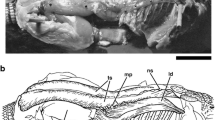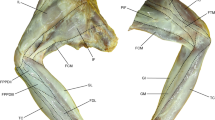Abstract
The procyonids (Procyon cancrivorus, Nasua nasua and Potos flavus) are Neotropical carnivorans with the ability to climb trees; however, each one has different locomotor preferences. Thereby, P. flavus is highly arboreal, P. cancrivorus is mainly terrestrial with abilities to swim, and N. nasua is also fossorial. These activities not only require movements of the hands but stabilize the thoracic limb, an action performed by the extrinsic muscles. Besides, former descriptions performed in procyonid species have obsolete terms for these muscles, generating confusion about the comparison among species. Thereby, muscle innervation has also been used to support the evolutionary derivation of the muscles. Therefore, this study aimed to describe the attachments and innervations of these muscles in three procyonids. There were intra- and interspecific anatomical variations in the attachments of all extrinsic thoracic limb muscles. However, based on the innervation, several evolutionary derivations in procyonids could be found, such as: the cleidobrachialis muscle derived from the deltoideus muscle; the atlantoscapularis muscle of P. flavus derived from the serratus ventralis cervicis muscle; the pectoralis transversus muscle derived from the pectoralis profundus and superficiales muscles; and the pectoralis abdominalis muscle derived from the cutaneus trunci muscle. Some functions could be associated with locomotor habits, among them a highly developed pectoralis abdominalis in Nasua for its fossorial habits and the atlantoscapularis in Potos for its arboreal and prehensile habits. Thus, the extrinsic muscles in procyonids have evolved for locomotor preferences, but mainly due to their phylogenetic relationship within the family Procyonidae.






Similar content being viewed by others
Data availability
All data generated in this study are available in this article.
References
Abdala V, Diogo R (2010) Comparative anatomy, homologies and evolution of the pectoral and forelimb musculature of tetrapods with special attention to extant limbed amphibians and reptiles. J Anat 217:536–573. https://doi.org/10.1111/j.1469-7580.2010.01278.x
Aguiar LM, Moro-Rios RF, Silvestre T et al (2011) Diet of brown-nosed coatis and crab-eating raccoons from a mosaic landscape with exotic plantations in southern Brazil. Stud Neotrop Fauna Environ 46:153–161. https://doi.org/10.1080/01650521.2011.640567
Allen H (1882) The muscles of the limbs of the raccoon (Procyon lotor). Proc Acad Nat Sci PA 34:115–144
Beswick-Perrin J (1871) On the myology of the limbs of the Kinkajou (Cercoleptes caudivolvulus). Proc Zool Soc Lond 1871:547–559
Böhmer C, Theil J-C, Fabre A-C, Herrel A (2020) Atlas of terrestrial mammal limbs. CRC Press Taylor & FRancis Groups, Boca Raton
Budras K, McCarthy P, Fricke W et al (2007) Anatomy of the dog, 5th edn. Schlütersche, Hannover
De Iuliis G, Pulerà D (2019) The dissection of vertebrates. Elsevier Inc., London
Diogo R, Abdala V (2010) Muscles of vertebrates: comparative anatomy, evolution, homologies and development, 1st edn. CRC Press, Enfield
Diogo R, Wood B (2012) Comparative anatomy and phylogeny of primate muscles and human evolution. CRC Press Taylor & FRancis Groups, Enfield
Diogo R, Abdala V, Aziz MA et al (2009) From fish to modern humans—comparative anatomy, homologies and evolution of the pectoral and forelimb musculature. J Anat 214:694–716. https://doi.org/10.1111/j.1469-7580.2009.01067.x
Diogo R, Bello-Hellegouarch G, Kohlsdorf T et al (2016) Comparative myology and evolution of marsupials and other vertebrates, with notes on complexity, Bauplan, and “Scala Naturae.” Anat Rec 299:1224–1255. https://doi.org/10.1002/ar.23390
Diogo R, Shearer B, Potau JM et al (2017) Photographic and descriptive musculoskeletal atlas of bonobos. Springer, Cham
Dyce KM, Sack WO, Wensing CJG (2012) Anatomía Veterinaria, 4th edn. El manual moderno, Ciudad de México
Enciso-García LM, Vélez-García JF (2022) Origin and distribution of the brachial plexus in kinkajou (Potos flavus – Schreber, 1774). Anat Histol Embryol 51:221–235. https://doi.org/10.1111/ahe.12781
Ercoli MD, Álvarez A, Stefanini MI et al (2015) Muscular anatomy of the forelimbs of the lesser grison (Galictis cuja), and a functional and phylogenetic overview of Mustelidae and other Caniformia. J Mamm Evol 22:57–91. https://doi.org/10.1007/s10914-014-9257-6
Evans HE, De Lahunta A (2017) Guide to the dissection of the dog, 8th edn. Elsevier Health Sciences, St. Louis
Getty R (1982) Anatomía de los animales domésticos de Sisson y Grossman Tomo II. Masson, Bogotá
Grzeczka A, Zdun M (2022) The structure of the brachial plexus in selected representatives of the Caniformia suborder. Animals 12:566. https://doi.org/10.3390/ani12050566
Hermanson J (2020) The muscular system. In: Hermanson JW, Evans H, De Lahunta A (eds) Miller’s anatomy of the dog, 5th edn. Elsevier Inc., St. Louis, pp 444–658
Hermanson J, Evans H, De Lahunta A (2020) Miller and Evan’s anatomy of the dog, 5th edn. Elsevier Inc., St. Louis
International Committee on Veterinary Gross Anatomical Nomenclature (2017) Nomina Anatómica veterinaria, 6th edn. World Association of Veterinary Anatomists, Hannover
Iwaniuk AN, Pellis SM, Whishaw IQ (2000) The relative importance of body size, phylogeny, locomotion, and diet in the evolution of forelimb dexterity in fissiped carnivores (Carnivora). Can J Zool 78:1110–1125. https://doi.org/10.1139/cjz-78-7-1110
Julitz C (1909) Osteologie und Myologie der Extremitäten und des Wickelschwanzes vom Wickelbären, Cercoleptes caudivolvulus, mit besonderer Berücksichtigung der Anpassungserscheinungen an das Baumleben. Arch Für Naturgesch 75:143–188
Koizumi M (2022) Comparative anatomy of the subscapularis, teres major and latissimus dorsi muscles from salamanders to mammals with special reference to their innervations from the brachial plexus. Anat Sci Int 97:124–137. https://doi.org/10.1007/s12565-021-00636-5
Langworthy OR (1924) The panniculus carnosus in cat and dog and its genetical relation to the pectoral musculature. J Mammal 5:49. https://doi.org/10.2307/1373485
Langworthy OR (1925) A morphological study of the panniculus carnosus and its genetical relationship to the pectoral musculature in rodents. Am J Anat 35:283–302. https://doi.org/10.1002/aja.1000350207
Langworthy OR (1932) The panniculus carnosus and pouch musculature of the opossum, a marsupial. J Mammal 13:241. https://doi.org/10.2307/1373999
Liebich HG, Maierl J, König HE (2020) Forelimbs or thoracic limbs (membra thoracica). In: König HE, Liebich HG (eds) Veterinary anatomy of domestic animals textbook and colour atlas, 7th edn. Georg Thieme Verlag, Stuttgart, pp 171–242
Mackintosh HW (1875) Notes on the myology of the Coati-Mondi (Nasua narica and N. fusca) and Common Martin (Martes foina). Proc R Irish Acad Sci 2:48–55
Martinelli MM, Volpi TA (2010) Diet of racoon Procyon cancrivorus (Carnivora, Procyonidae) in a mangrove and restinga area in Espirito Santo state, Brazil. Nat on-Line 8:150–151
McClearn D (1992) Locomotion, posture, and feeding behavior of kinkajous, coatis, and raccoons. J Mammal 73:245–261
Molnar JL, Diogo R (2021) Evolution, homology, and development of tetrapod limb muscles. Diversity 13:393. https://doi.org/10.3390/d13080393
Nagashima H, Sugahara F, Takechi M et al (2009) Evolution of the turtle body plan by the folding and creation of new muscle connections. Science 325:193–196. https://doi.org/10.1126/science.1173826
Nyakatura K, Bininda-Emonds OR (2012) Updating the evolutionary history of Carnivora (Mammalia): a new species-level supertree complete with divergence time estimates. BMC Biol 10:12. https://doi.org/10.1186/1741-7007-10-12
Perdomo-Cárdenas V, Patiño-Holguín C, Vélez-García JF (2021) Evolutionary and terminological analysis of the flexor digitorum superficialis, interflexorii and palmaris longus muscles in kinkajou (Potos flavus) and crab-eating racoon (Procyon cancrivorus). J Vet Med Ser C Anat Histol Embryol. https://doi.org/10.1111/ahe.12656
Pereira KF, de Souza DR, Ferreira LS, Ribeiro AR (2012) Aspectos morfológicos dos músculos da cabeça e pescoço do mão pelada (Procyon cancrivorus). SaBios-Revista Saúde e Biol 7:1–8
Reighard J, Jennings HS (1901) Anatomy of the cat. Henry Holt and Company, New York
Sebastiani M, Fishbeck DW (2005) Mammalian anatomy: the cat, 2nd edn. Morton Publishing Company, Englewood
Smith HF, Townsend KEB, Adrian B et al (2021) Functional adaptations in the forelimb of the snow leopard (Panthera uncia). Integr Comp Biol 61:1852–1866. https://doi.org/10.1093/icb/icab018
Souza-Junior P, Carvalho NC, Mattos K, Santos ALQ (2014) Origens e ramificações do plexo braquial no cachorro-do-mato Cerdocyon thous (Linnaeus, 1766). Pesqui Veterinária Bras 34:1011–1023. https://doi.org/10.1590/S0100-736X2014001000015
Souza-Junior P, da Cruz de Carvalho N, de Mattos K et al (2017) Brachial plexus in the Pampas fox (Lycalopex gymnocercus): a descriptive and comparative analysis. Anat Rec 300:537–548. https://doi.org/10.1002/ar.23509
Souza-Junior P, dos Santos LMRP, Viotto-Souza W et al (2018) Functional myology of the thoracic limb in Pampas fox (Lycalopex gymnocercus): a descriptive and comparative analysis. J Anat 233:783–806. https://doi.org/10.1111/joa.12892
Stein BR (1981) Comparative limb myology of two opossums, Didelphis and Chironectes. J Morphol 169:113–140. https://doi.org/10.1002/jmor.1051690109
Taverne M, Fabre A-C, Herbin M et al (2018) Convergence in the functional properties of forelimb muscles in carnivorans: adaptations to an arboreal lifestyle? Biol J Linn Soc. https://doi.org/10.1093/biolinnean/bly123
Vélez-García JF, Arbeláez-Quiñones AC, Montealegre-Hurtado KD (2021a) Evolutionary adaptations in the flexor digitorum profundus muscle in Tamandua mexicana (Xenarthra, Myrmecophagidae). Anat Rec 304:758–770. https://doi.org/10.1002/ar.24502
Vélez-García JF, Castañeda-Herrera FE, Ospina-Herrera O et al (2021b) Atlas anatómico del tití gris (Saguinus leucopus). Artes pixelar S. A., Manizalez
Windle B (1888) Notes on the limb myology of Procyon cancrivorus and of the Ursidae. J Anat Physiol 23:81–89
Windle B, Parsons F (1897) Myology of the terrestrial carnivora. Part I. Muscles of the head, neck, and fore-limb. Proc Zool Soc Lond 65:370–409
Acknowledgements
We want to thank Universidad del Tolima, Universidade de São Paulo and CAPES (Coordenação de Aperfeiçoamento de Pessoal de Nível Superior, Bolsa No. 88887.685526/2022-00) for support this research, and special thanks to CORTOLIMA and CORPOCALDAS for donating the cadavers.
Funding
This research was funded by grants from the Central Research Office of the University of Tolima to Juan Fernando Vélez García (Project Number 390116).
Author information
Authors and Affiliations
Contributions
All authors contributed to the study conception and design. Material preparation, data collection and analysis of the muscles were performed by JFVG. The first draft of the manuscript was written by JFVG, and MAM commented on posterior versions of the manuscript. All authors read and approved the final manuscript.
Corresponding author
Ethics declarations
Conflict of interest
The authors declare that they have no conflict of interest.
Additional information
Publisher's Note
Springer Nature remains neutral with regard to jurisdictional claims in published maps and institutional affiliations.
Rights and permissions
Springer Nature or its licensor (e.g. a society or other partner) holds exclusive rights to this article under a publishing agreement with the author(s) or other rightsholder(s); author self-archiving of the accepted manuscript version of this article is solely governed by the terms of such publishing agreement and applicable law.
About this article
Cite this article
Vélez-García, J.F., Miglino, M.A. Evolutionary comparative analysis of the extrinsic thoracic limb muscles in three procyonids (Procyon cancrivorus Cuvier, 1798, Nasua nasua Linnaeus, 1766, and Potos flavus Schreber, 1774) based on their attachments and innervation. Anat Sci Int 98, 273–292 (2023). https://doi.org/10.1007/s12565-022-00696-1
Received:
Accepted:
Published:
Issue Date:
DOI: https://doi.org/10.1007/s12565-022-00696-1




